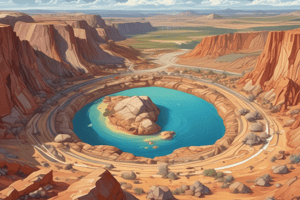Podcast
Questions and Answers
What type of rocks result from high heat and pressure altering their composition and structure?
What type of rocks result from high heat and pressure altering their composition and structure?
- Sedimentary rocks
- Volcanic rocks
- Igneous rocks
- Metamorphic rocks (correct)
Which process leads to the recrystallization of existing rocks, creating new minerals and textures?
Which process leads to the recrystallization of existing rocks, creating new minerals and textures?
- Erosion
- Weathering
- Heat and pressure (correct)
- Freezing
In the rock cycle, which type of rock can be elevated by tectonic movements, subjected to weathering, and ultimately remelt to form magma?
In the rock cycle, which type of rock can be elevated by tectonic movements, subjected to weathering, and ultimately remelt to form magma?
- Sedimentary rocks (correct)
- Igneous rocks
- Volcanic rocks
- Metamorphic rocks
Which type of rock can directly transition between stages or be recycled multiple times in the rock cycle?
Which type of rock can directly transition between stages or be recycled multiple times in the rock cycle?
What is the primary source of heat that causes existing rocks to recrystallize during metamorphism?
What is the primary source of heat that causes existing rocks to recrystallize during metamorphism?
How do metamorphic rocks like marble, schist, and gneiss form?
How do metamorphic rocks like marble, schist, and gneiss form?
How do intrusive igneous rocks form?
How do intrusive igneous rocks form?
Which type of rock forms from pre-existing rock fragments or mineral particles that accumulate over time?
Which type of rock forms from pre-existing rock fragments or mineral particles that accumulate over time?
What process leads to the formation of layered rocks like sandstone and conglomerate?
What process leads to the formation of layered rocks like sandstone and conglomerate?
Which type of rock forms when magma rapidly cools upon reaching the surface due to volcanic eruptions?
Which type of rock forms when magma rapidly cools upon reaching the surface due to volcanic eruptions?
What type of rock originates from the conversion of plant and animal matter into rock?
What type of rock originates from the conversion of plant and animal matter into rock?
What are examples of extrusive igneous rocks?
What are examples of extrusive igneous rocks?
Flashcards are hidden until you start studying
Study Notes
Introduction
The rock cycle is a fundamental concept in Earth science, describing how the three main types of rocks — igneous, sedimentary, and metamorphic — are transformed and produced through various processes occurring on Earth's surface and internally.
Formation of Igneous Rocks
Igneous rocks originate from magma, a liquid mixture of molten rock materials and dissolved gases. When magma cools and solidifies, it forms igneous rocks. Two types of igneous rocks exist: intrusive igneous rocks, which form when magma cools slowly below the Earth's surface, and extrusive igneous rocks, which form when magma rapidly cools upon reaching the surface due to volcanic eruptions. Examples of igneous rocks include granite and pumice.
Formation of Sedimentary Rocks
Sedimentary rocks are formed from pre-existing rock fragments or mineral particles that accumulate over time through weathering and erosion. Processes such as wind, water, and gravity carry these particles to new locations where they become deposited, eventually compressed and cemented together to form layered rocks like sandstone and conglomerate. Additionally, chemicals dissolved in water can precipitate out of solution, forming rocks like gypsum and halite. Fossilization, the conversion of plant and animal matter into rock, occurs during the formation of sedimentary rocks, preserving evidence of past life.
Transformation of Rocks through Metamorphism
Metamorphic rocks result from high heat and pressure applied to existing rocks, altering their composition and structure. Heat generated by the Earth's core or by shallow intrusions of magma causes existing rocks to recrystallize, creating new minerals and textures. Examples of metamorphic rocks include marble, schist, and gneiss.
Interactions among Rock Types
The rock cycle is nonlinear, meaning rocks do not necessarily follow a set path from igneous to sedimentary to metamorphic or vice versa. A rock can transition directly between stages or be recycled multiple times, sometimes even returning to its original form after being altered significantly. For instance, sedimentary rocks can be elevated by tectonic movements, subjected to weathering and erosion, and ultimately remelt to form magma once again.
Conclusion
Understanding the rock cycle allows us to appreciate the complex interactions that shape the Earth's surface and crust. It demonstrates how the geological record, preserved in sedimentary rocks, reveals details about the climate, continental positions, and species extinctions throughout Earth's history. Furthermore, studying the rock cycle can aid in predicting future earthquake risk, assessing potential mineral reserves, and managing human impacts on natural systems.
Studying That Suits You
Use AI to generate personalized quizzes and flashcards to suit your learning preferences.





